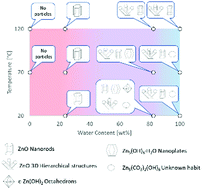Oxidative ionothermal synthesis for micro and macro Zn-based materials†
Abstract
Zinc oxide (ZnO) is a multifunctional nanomaterial with a wide range of applications ranging from biosensors to solar cells. It is mainly mass-produced by air-oxidising vaporised metallic zinc at high temperatures without good particle uniformity. In a quest for environmentally-benign, cost-effective and high particle uniformity fabrication methods, many strategies had been proposed. However, recent methods utilise Zn salts as starting materials, produced commercially from metallic zinc, instead of the metallic Zn itself. We demonstrate that ZnO nano–macro particles (e.g. nanorods, needles and hierarchical structures) and other compounds [Zn(OH)2, Zn5(OH)8Cl2 or Zn5(OH)6(CO3)2] form spontaneously by direct oxidation of metallic zinc in aqueous ionic liquids (1-butyl-3-methylimidazolium chloride). Further, their chemical structure and morphology can be controlled by adjusting the concentration, temperature and exposure time. The environmentally benign and tunable nature of this novel oxidative ionothermal synthesis offers potential for new avenues towards application-motivated tailoring of ZnO and other nano and macro materials fabrication.

- This article is part of the themed collections: Celebrating Materials Science in the UK and Welcome to the community


 Please wait while we load your content...
Please wait while we load your content...